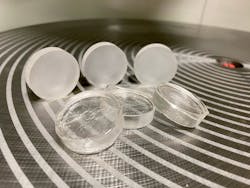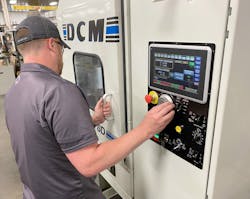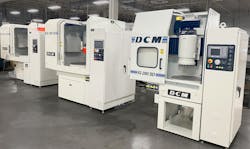For engineers, managers, researchers, and technical professionals relying on lasers, selecting and utilizing precision photonics components is a necessary part of reliably achieving their goals. A key aspect of the process involves the extremely accurate grinding of optical components from standard forms of glass, ceramics, and other materials to specified tolerances.
Today, automated surface grinders are capable of producing very precise optical components with less processing time, while minimizing damage and operator error.
Mike Anderson, a technical specialist at DCM Tech, a Winona, MN-based designer and builder of industrial rotary surface grinders, discusses the advantages of precision grinding.
Q: In what ways are optical components critical for laser applications? What grinding criteria may be involved, and how can advanced grinders help with this?
A: Optical components, which allow light transmission through a transparent medium such as glass or ceramic, play a critical role in all photonics applications. They fall into two basic groups—transmissives (lenses, filters, windows, optical flats) and reflectives (mirrors and retroreflectors). The raw materials come in a variety of shapes, sizes, and types with surfaces that are spherical, aspheric, convex, or cylindrical. They can be made from several hundred common glasses or from complex materials such as fused silica or calcium fluoride.
Flat, or plano, optics involve a range of optical components with flat, parallel surfaces with very little wedge. A plane mirror used to redirect light along an optical path, for example, is critical for applications involving images or large beam sizes because variations can alter the reflected wavefront and increase image distortion.
For many laser applications, the optical components must be flat and parallel, with a polished finish devoid of surface damage to avoid misdirecting or scattering the light.
To achieve the precise wedge or parallelism, the components must be precisely ground and finished to extremely tight dimensional tolerances.
Fortunately, advanced, automated rotary surface grinders offer advanced sensors and controls that can precisely direct the grinding process to achieve the required specifications in much less time, to ensure optimal component quality and performance. The advanced grinding equipment may also significantly reduce intermediate lapping steps and the risk of breakage of high-value optical components, further reducing costs.
Q: What is the role grinding optical components plays in the photonics industry?
A: In the photonics industry, grinding is the first step toward creating optical glass with the required size and surface for high-quality photonics parts.
To achieve this, photonic materials are ground down from stock material of varying size, shape, and thickness. After optical components are initially ground to remove significant amounts of material to get close to the specified size, each component is further refined. Finer grinding and polishing is performed to reach precise dimensions, tight tolerances, and a final finish—this can be challenging with older conventional grinders.
In optics, you start with a surface grinder to get down to microns; when you finish lapping and polishing the optics, you are in the range of nanometers. At that point, the photonics parts should perform optically and interferometrically, allowing measurement using the phenomenon of light wave interference as expected.
Q: What equipment is used for grinding optical components, and what challenges can occur with traditional options?
A: Traditional rotary surface grinders can lack accuracy and reliability in the hands of less experienced operators. With limited control of spindle speeds as well as manual controls, the older equipment requires sophisticated operators with a subtle touch who can also make complex calculations. Considerable expertise and experience are required, which can be a challenge as skilled operators retire.
With rotary table surface grinders, the table rotates with the workpiece held firmly in place underneath a vertical spindle. With this approach, the grinding is not performed by the peripheral edge of the wheel, but rather by the entire diameter of the abrasive surface.
Q: How have modern surface grinders advanced, and what are the benefits for grinding optical components?
A: Surface grinders today have much more advanced sensors and controls that automatically maintain extremely tight tolerances. Digital technology allows for an interface with easy-to-use touchscreen controls.
Compared to traditional grinding equipment with manual controls that require experienced machinists to be familiar with the nuances of each machine, these automated units consistently produce higher quality parts in less time. As a result, a growing number of photonic component manufacturers and machine shops are installing new grinders that can be operated by less experienced personnel while still achieving the desired results.
Q: What is an example of how using advanced automated surface grinders can help with grinding optical components?
A: I know of an optical manufacturing engineer whose company replaced its manually operated rotary surface grinder with an alternative from DCM Tech. The IG 280 SD has a 24-in variable speed table and a 20 HP variable speed grinding spindle motor. With advanced sensors and controls, the surface grinder can remove material down to one ten-thousandth of an inch of the final thickness (see Fig. 1).
The optical engineer said they can precisely control the grind so that it cuts very well while minimizing damage. That makes it easy for one operator with optical knowledge to use, even if they lack experience with manual machines.
The grinding equipment is designed with three settings that enable an easy transition from a rough to a fine grind, along with selecting a specified dwell time.
Due to the success of the first system this optical engineer purchased, and to allow grinding of larger components, their company recently bought an IG 482 SD model with a 48-in rotary table, precision cross slide, and an option for part detection.
Q: How can automated surface grinders help prevent high-value optical part damage and inefficiency?
A: Specialized optical components can cost thousands of dollars per part, so reducing or eliminating damage caused during grinding can add substantially to the bottom line.
According to the aforementioned optical engineer, the manually operated grinding process was inefficient, and some of the optical-grade material was ruined due to heat fractures, leading to low-yields.
However, advanced rotary grinders offer superior control with features that minimize potential damage. The automated rotary surface grinder is designed to significantly reduce or eliminate subsurface damage and edge chipping, which is a common performance gauge for operations that combine the grinding, lapping, and polishing steps in sequence. By grinding in an extremely precise, efficient manner, each subsequent step requires less time.
An adjustable magnetic chuck facilitates the process by securely holding and constraining each workpiece as it is typically ground from round or rectangular stock and shaped to the necessary specifications.
There is also value in an optional rotary surface grinder load meter, which can help prevent excessive load-related damage to the optical workpiece.
The load meter can be particularly useful when grinding hard materials. Set the load meter to a certain setpoint and it will dwell at that point. If the meter senses the load has reached the setpoint, it will pause the automatic feed to avoid excessive pressure between the grinding wheel and the workpiece, and this prevents damage.
Q: Are other automated surface grinder options available that can further reduce optical part damage?
A: Several additional options are available on all DCM Tech grinders, for example, that can significantly reduce optical component damage: sensors for coolant flow, vacuum flow, and part detection.
When grinding an optical component, coolant flows to the workpiece. If the flow ceases, heat buildup can damage the component. A coolant flow sensor can prevent this issue. Such sensors can detect when the flow stops or diminishes and directs the machine to retract the grinding head away from the part to avoid damage (see Fig. 2).When a machine shop uses a vacuum chuck to secure an optical part, any loss in vacuum between the fixture and workpiece can release the part, leading to breakage. In this case, incorporating a vacuum flow sensor can prevent the quality assurance risk. If the flow sensor detects a drop in vacuum, the grinding head will retract from the part.
In the grinding process, initiating contact with the optical component is critical. If the operator has difficulty determining contact or misjudges, it can compromise the part. Using a grinder with part detection capability can eliminate this sort of operator error by automatically finding the point of contact (see Fig. 3).The machine can fine-tune not only the pressure of the spindle motor but how quickly it moves the wheel down onto the part. When the machine senses the abrasive wheel has contacted the part, it switches into grinding mode and manages itself, relieving the operator of the responsibility.
Q: Since optical component quality is critical in laser applications, what grinder options are available that can help control the inevitable debris that results from grinding?
A: When having a clean shop is desired, selecting a rotary unit with an integrated shroud to contain debris while grinding is important. In addition to a shroud, grinders like the IG series provide an integral air mist collection system that draws particulates from the air and moves them away from the operator to enhance cleanliness and safety. To further safeguard quality, the grinders provide through-spindle and external coolant flow as well as a self-contained recirculating filtration system with a pre-filter and in-line canister filter.
Engineers and scientists who rely on lasers are knowledgeable about photonics yet may not specialize in grinding photonics. By learning about and utilizing some of the advanced grinding technology offered today, they can significantly reduce optical component damage while improving efficiency and overall laser system reliability.
About the Author
Mike Anderson
Technical Specialist, DCM Tech
Mike Anderson is a technical specialist at DCM Tech (Winona, MN), a designer and builder of industrial rotary surface grinders.


